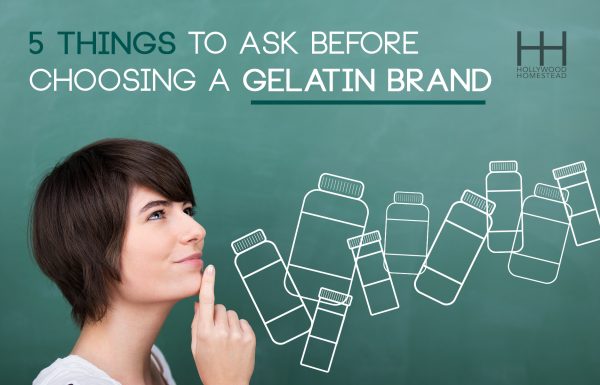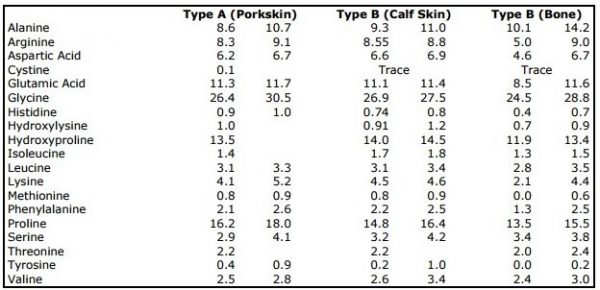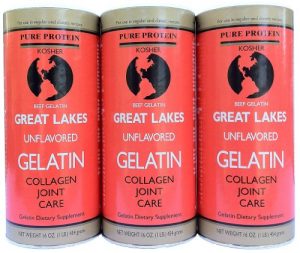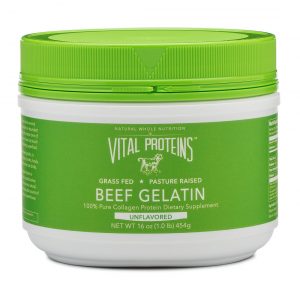
Gelatin is one of the ultimate superfoods that is proven to help joints, skin, bones, digestive health, and even mood disorders. Because gelatin is made from the parts of animals which we normally don’t eat, it is also a great way to ensure you are getting a balanced amino acid intake.
I’m not going to talk about the health benefits of gelatin here. If you want to learn more about that, I suggest you read The Gelatin Secret. In addition to having comprehensive information about how gelatin can improve your health, there are also dozens of gelatin recipes so you can start including more gelatin into your life.
Because there are so many health benefits of gelatin, it is no surprise that many gelatin brands have recently come onto the scene.
But, for health benefits, not just any gelatin brand will do!
Like with all superfoods, quality really matters when choosing a gelatin brand. I know it can be confusing to make sense of the dozens of gelatin brands out there. So, this guide will tell you what factors to consider when choosing a gelatin.
1. What Animal Was Used to Make the Gelatin?
Gelatin is made from boiling down the connective tissues of animals. Virtually any connective tissues could be used. However, in the United States, it is mostly pig skins, cow skins, and fish skin. Demineralized bone is also often used. In China, donkey skin is commonly used. (Source)
As the chart below shows, the choice of animal doesn’t really affect the nutritional composition (I couldn’t find any stats on nutritional composition of gelatin made from fish, so I can’t attest to how it compares nutritionally).
However, it does matter that the brand lists what animals are being used.
As Emily Benfit notes here and Food Babe talks about here, unless the gelatin brand says from what kind of animal, you can be fairly certain that it is a byproduct of the CAFO factory farming industry. That means hormones, antibiotics, pesticides, GMOs, and god knows what else in your gelatin!
Takeaway: Only choose a gelatin brand which lists which animals were used. Bonus points if it lists what part of the animal was used.

2. Is the Gelatin Grass-Fed and Pastured?
While the choice of animal might not affect nutritional content much, the way that the animal was raised could.
Studies have found that grass-fed cows are much more nutritious than grain-fed cows. For more on this, read this post about What Is Grass-Fed Gelatin.
Unfortunately, there is a lot less control and oversight into how pigs are fed than cows. For this reason, it is better always choose grass-fed bovine gelatin over porcine gelatin.
Takeaway: Choose grass-fed, pasture-raised gelatin whenever possible. It will cost a bit more but is worth it for the nutritional benefits.
3. How Was the Gelatin Made?
There are two main ways that gelatin is processed. Not surprisingly, processing method does matter!
The Acidic Method (Type A Gelatin):
- Used mainly for pig skin and fish skin
- The collagen is acidified and then heated to boiling; it is then defatted, filtered, and vacuum-evaporated or treated with membrane ultra-filtration
- Considered to be the lower-quality method of making gelatin
- Acids can destroy amino acids and nutrients in the gelatin.
- Traces of the acid can remain in the gelatin!
The Alkaline Method (Type B Gelatin):
- Used mainly for cattle hides and bones
- The collagen is treated with a caustic soda or liming process; it is then washed, denatured, and converted into gelatin by heating it
- Considered to be the better method of making gelatin
As you can see from the table below, Type B gelatin is much more nutritious. Some gelatin brands (like Vital Proteins) give out information about their manufacturing process, but most gelatin brands unfortunately don’t.
But remember that Type B gelatin is usually made from cow hides. So, if you don’t know what manufacturing process was used for the gelatin, opt for bovine gelatin. (Source 1)
Takeaway: Do some research and find out what method was used for making the gelatin. If you can’t find this information, then bovine gelatin is the best bet.

4. Is the Gelatin Contaminated with Heavy Metals or Sulphur Dioxide?
Depending on the brand of gelatin, there may be a lot of chemicals which are used in the manufacturing process. Some of the big ones are: hydrochloric acid, calcium hydroxide, or sulphur dioxide, and hydrogen peroxide.
Likewise, gelatin can have high levels of heavy metal contamination. (Source)
These are not substances you want in your gelatin! The best brands of gelatin will test their product and make publicly available the levels of heavy metals and other contaminants. For example, Vital Proteins has a policy where they allow zero detectable levels of heavy metals. Great Lakes gelatin publishes the levels of heavy metals on their website.
Takeaway: Choose trustworthy gelatin brands which disclose this information.
5. Does the Gelatin Contain Additives?
By now, most people know that food additives are dangerous. However, I’m not sure people realize just how dangerous they are. This has already been written about extensively, so I won’t dwell on it here. If you want more info, I suggest reading these:
- Food Additives Could Be Dangerous to Health by Live Science
- The Paleo Guide to Food Additives
- Food Additives Ebook by Chris Kresser
Unfortunately, the most popular gelatin brands (I’m thinking of you, Jell-O!) do use additives. You might not be able to find anything without additives in your supermarket.
Takeaway: Shop online for gelatin. You will have many more options when it comes to additive-free gelatin brands.
My Favorite Brands of Gelatin
You can absolutely forget about Jell-O. They are owned by Kraft, which has a terrible reputation for using chemical ingredients. Jell-O is also full of additives like preservatives and artificial flavoring.
I know a lot of people like Knox Gelatin. Compared to Jell-O, Knox is definitely the better choice because it doesn’t have any additives. However, it is likely made from CAFO factory farm animals who aren’t healthy (and thus won’t produce a nutritious gelatin). We also can’t be confident that there aren’t traces of antibiotics, GMOs, heavy metals, and other contaminants in Knox.
So what gelatin do I use instead? My favorite gelatin brands are Great Lakes Kosher (Bovine) Gelatin and Vital Proteins Beef Gelatin.

Both of these brands are made from grass-fed cows using the Type B manufacturing process which keeps more nutrients intact. They also publicly disclose quality control tests and have a zero-tolerance policy for GMOs, antibiotics, and hormones.

Vital Proteins is a bit pricier of the two brands, but its beef are also pasture-raised and they provide a lot more information about the quality of their gelatin. Plus, they don’t not allow any detectable heavy metals into their gelatin whereas Great Lakes permits very small amounts.
***You can buy Great Lakes Gelatin Here***
***You can buy Vital Proteins Gelatin Here***
If you want to learn more about gelatin, download my book The Gelatin Secret. You’ll learn about the health benefits of gelatin, how to make your own gelatin, and get dozens of great gelatin recipes. Buy the Gelatin Secret here.


Latest posts by Sylvie McCracken (see all)
- Treating H. Pylori (Part 3): What H. Pylori Does to the Body - August 8, 2022
- Treating H. Pylori (Part 2): How H. Pylori is Contracted - August 3, 2022
- Understanding Beef Labels: Organic, Pastured, Grass-Fed & Grain-Finished - July 25, 2022
Why Vital Proteins uses Brazilian cows would be an AWESOME topic for you to explore in a future post or perhaps you can send me some information or a contact there? Especially since one of the largest causes of Rainforest destruction is cattle production where they clear the Rainforest to make ranches for cattle in Brazil. I almost pulled the trigger on buying some for a medical issue I’m treating as it seems like a superior product, but then I had to dig deep into Amazon.com comments to find the cows are from Brazil, of all countries, they are grown on grass in Brazil! Seems so bizarre! And the product is not labeled Rainforest Safe, so I’m sure that they aren’t coming from sustainable ranches. Thanks in advance! Alas, for now I will not be buying Vital Proteins products.
My go to brand is Perfect Supplements for collagen and gelatin. Have you looked at them at all? Price point is good too. I put the collagen in my coffee
My apologies on the miss spelling of your name ! : )
I am very confused about the use of gelatin for SIBO! I have read many conflicting facts about if it is a benefit or not. I use the hydrolyzed peptide version because I don’t think I could tolerate the regular gelatin due to the thickness. I am at the end of my second round of antibiotics, the first being prescription, the second being herbal. I have been doing the Low FOD diet for about 4 months during this process. I think that I am possibly reacting to the hydrolyzed – peptide gelatin, more extreme than others at times, but not completely sure that that is the cause. What I am confused most about with using gelatin with SIBO is that it has free glutamate in it which is not good technically for anyone especially with this condition. Although it is supposed to heal your stomach among other things, I don’t understand how it can benefit us with this condition due to the free glutamate. All the research I have read claims that it causes havoc in many problems. I am also confused as to how gelatin could be so good for us with this condition where the whole process involved results in high histamine levels which Is also bad for SIBO. I’m not sure but I feel that I may have been doing myself an injustice during this whole healing process. I feel that I should not be experiencing symptoms at this point with all the diligence and dedication that I have maintained throughout my healing process. Could you please enlighten me? TY
It’s a GREAT question, Robin and I have a blog post going up in a handful of days all about gelatin and SIBO-stay tuned. Of course, as always, it’s highly individual.
In the meantime, any time a food or supplement is clearly not benefiting you- STOP taking it. Plain and simple.
Thank you Sylvia for your prompt response. I was hoping that you might have had some information or could perhaps direct me as I am dealing with some symptoms currently. I have eliminated the collagen peptide in the meantime which goes without saying. As I mentioned, I am not positive it is due to the “hydrolyzed” gelatin or not. I was hoping that some of the information you provide could help me ascertain if this is likely. As I’m sure you understand, it can be quite confusing as you’re trying to sort through all these things during the treatment phase (die-off/detox, histamine, fructose intolerance, etc). Is there anywhere online that you can direct me to in an effort to gain knowledge on the matter? In my research, I have also found that anything “hydrolyzed” is basically another name for MSG or a form they’re of… there lies another problem I assume! I wonder if that form of collagen should be recommended at all, never mind for people with SIBO! Looking forward to your article.
I started taking the Great Lakes Collagen about two weeks ago, just one tablespoon a day and have gained four pounds since starting. I’m a little panicked. Is this normal? I’m not working out so I wouldn’t think it would be muscle gain. I hadn’t changed anything else in my diet or day-to-day life.
That’s really interesting Dayna. Only thing I can think of (I’m not a doctor) is whether you’re allergic perhaps and retaining water for some reason. I’d stop taking it.
The exact same thing happened to me – I have been a healthy weight my entire week and as soon as I started taking the Great Lakes Collagen I started to put on weight like never before. It is quite common, as is bloating, just read the reviews on Amazon